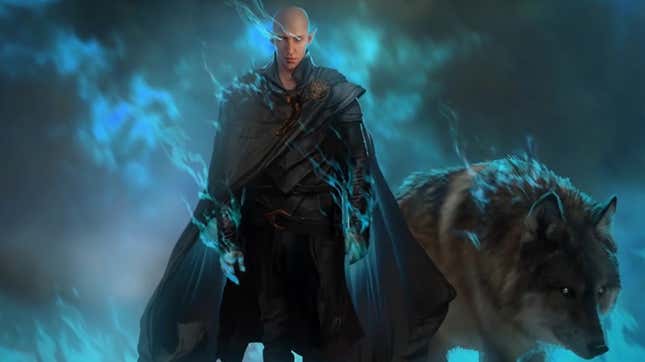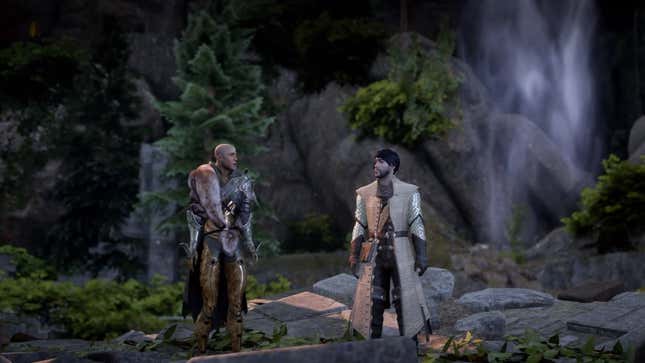Yesterday, BioWare announced Dragon Age: The Veilguard will finally come to PC and consoles on October 31. We broke down the 3-minute announcement trailer, but I had to restrain myself from getting too into the weeds. Yeah, theory-crafting is fun, but folks looking for a bird’s-eye view of what’s going down in that trailer aren’t interested in me breaking down the deep dwarven lore of the Dragon Age universe that might explain why returning character Scout Harding can use magic despite dwarves not typically being able to do that in this universe.
BioWare’s dark fantasy series is a dense tapestry of history and trying to get someone caught up in time for The Veilguard is a massive undertaking. So while I can’t explain everything that’s ever unfolded in the fantastical world of Thedas in a timely manner, I can at least try to get you caught up on what’s going down in The Veilguard before it launches on Halloween.
The Veilguard is the next chapter in a 10-year-old lover’s quarrel

So you’ve probably seen this guy, right? This bald elf is Solas, a Dragon Age: Inquisition party member. He’s a mage who is an expert on The Fade, a magical and spiritual plane of existence that is distinctly separate from the rest of the world. During the events of Inquisition, rifts were appearing throughout the physical realm that allowed spirits and demons to escape The Fade and terrorize the masses. Having an expert on the spirit world during this time seemed like a sensible idea, and this guy Solas just happened to be around when the sky opened up and demons started pouring out.
But Solas is more than just an expert on the supernatural, he’s also secretly the elven trickster god known as the Dread Wolf. This is revealed in a Marvel-esque stinger in the post-credits scene. It turns out that Solas’ misuse of an elven artifact is the reason the entire world went to shit in Inquisition, but now that he’s helped solve that issue, he’s getting back to his original plan: tear down The Veil that separates the physical world from the spiritual one. Doing so will reconnect the elves with the magic of the Fade, including bringing back their immortality. However, it will also result in the death of everyone else.

Naturally, players have been pissed about this treachery for over a decade. Some Dragon Age fans were in a romantic relationship with Solas, only for him to leave them in the eleventh hour to go off and do a world-ending cataclysm. You might be like me, who views Solas as a friend, who is hoping to somehow redeem Solas when Veilguard drops later this year. Or, you might absolutely loathe the dude for his snobby, know-it-all attitude, and this reveal just solidifies that you caught on to the bad vibes before everyone else. But no one is more ready to wail on this man’s bald head than a woman scorned by his god complex. The Dragon Age fandom has been on this ride for 10 years, but it’s the Solasmancers who are at the wheel, ready to floor it the second they see him in the headlights.
While some fans are ready to face Solas on behalf of their Inquisition protagonist, The Veilguard stars a new hero named Rook who is dragged into this conflict and has no previous relationship with our elven would-be terrorist. Solas created the barrier between both worlds to trap the other elven gods in the Fade as retribution for their killing of Mythal, a beloved elven god with whom Solas was close. Now, thanks to Rook’s meddling, they’re free to walk among the rest of the world, which appears to be the core conflict of The Veilguard. While fans have viewed Solas as an antagonist for a decade, it seems he is more or less the catalyst for the conflict, rather than the antagonist.
Some rapid-fire Dragon Age terms
That’s the baseline explanation you can give to your friend who’s thinking about jumping into The Veilguard with no prior knowledge. But Dragon Age has extensive lore and so many heady concepts that would need explaining to a newbie. So here’s some rapid-fire shorthand for all the word salad your friends may have to learn about.
- Thedas – The Dragon Age setting…get it? The Dragon Age setting?
- The Circle of Magi – It’s basically Hogwarts but the mages that are there are forced to be there by the church because they were Born This Way.
- Blood magic – It’s like when a Dungeons & Dragons warlock makes a deal with a devil to get extraordinary powers but with the asterisk of blood sacrifice. It doesn’t have to be your blood, though.
- Phylactery – A vial of blood that drops a pin to find mages who run away.
- Harrowing – Exposure therapy to demons so mages can prove they’re not susceptible to corruption.
- Tranquil – It’s a Mage lobotomy.
- Apostate – A mage who decided to leave the Circle during their gap year and never went back.
- The Chantry – The church with all the same corruption, propaganda, and overreach you’ve come to expect with a religious institution.
- The Maker – God
- Andraste – “God’s wife” – Borat voice
- The Divine – Dragon Age pope
- Templars – Church cops who huff explosive materials to oppress people
- Seekers – Church cops but in secret
- Lyrium – The blue liquid life force that powers most things in the Dragon Age universe. It’s like water, but magic and addictive.
- Red Lyrium – The same but corrupted so it’s bad, actually.
- Darkspawn – Definitely not the orcs from Lord of the Rings.
- Archdemon – An old god that takes the form of a dragon that you will inevitably fight at the end of a game, probably.
- The Blight – A moment in history when Darkspawn find the spirit of an old god underground and then have murder parties on the surface.
- Grey Wardens – The faction who drinks Darkspawn blood so they can fight them until they eventually die from drinking the blood of their enemies.
- The Taint – You can figure that one out for yourself. Try Google.
- Deep Roads – Underground tunnels everyone gets lost in except for Darkspawn, who always manage to find their way out.
- Dalish elves – Nomadic elves who still follow the old elven teachings. Or, well, the version of it that has survived over the years. They’re in for a rude awakening in The Veilguard.
- City elves – Elves who have integrated into human-led society.
- Alienage – The typically impoverished spaces in big cities where elves are allowed to live by human rule.
- Eluvian – Mirror portals
- Flemeth – A powerful mage who started out as a witch-like hag in Origins then became the hottest MILF you’ve ever seen in every game that followed.
- Golden City/Black City – A metropolis in the Fade that was once believed to be the home of The Maker. It was corrupted when powerful Tevinter mages invaded it, turning the once golden city into a black distortion, corrupting the mages into the first Darkspawn.
- Dorian Pavus – The best character in the series.
- The Fade – The worst section in any Dragon Age game.
- Antivan Crows – A group of assassins whose first impression in the series was failing miserably.
- Tevinter – A mage-ruled country that still utilizes Blood Magic, slavery, and other forms of magic-driven oppression. Though it seems to be undergoing a moment of great change in The Veilguard.
- Kirkwall – The city where the Mage Rebellion began, leading to the dismantling of or reforming of the Circle and Templar order.
- Fereldan – The podunk south of Thedas
- Orlais – Do you like Bridgerton?
- The Qun/Qunari – The name used interchangeably for both a horned race and a code they follow/spread to other races across the Dragon Age world.
- Sandal – Enchantment!
- Bianca – Varric’s crossbow named after his long-lost lover who fans are still mourning.
- The Hero of Ferelden – The character you play in Dragon Age: Origins who had too many branching conclusions to ever show up again.
- The Champion of Kirkwall/Hawke – The character you play in Dragon Age II who has a bunch of bisexual friends scattered across Thedas.
- The Herald of Andraste/Inquisitor – The character you play in Dragon Age: Inquisition who is missing an arm because they needed a reason to make them not the protagonist of The Veilguard.
That’s a whole lot of terms, but if you’re not looking to play the first three Dragon Age games, it should be enough to help you get through The Veilguard. If you are considering marathoning all three games before October 31, you can hit the most important stuff by playing only some of the DLCs. Here’s a breakdown of that for those who want to see the most plot-critical stuff in a time crunch.


